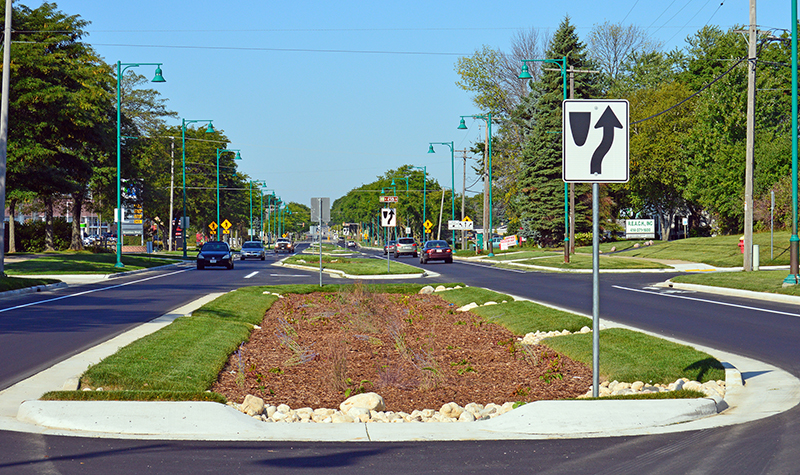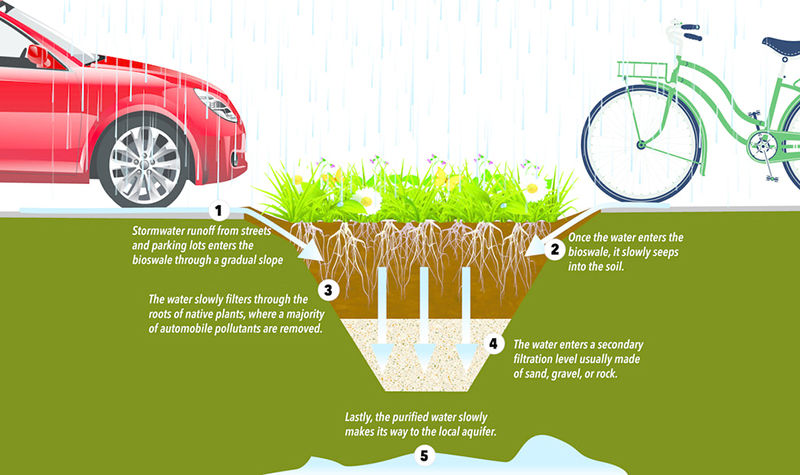Bioswales: More Than Just a Ditch

Consider the lowly ditch: a sometimes weed-choked area along the side of the roadway or at the edge of a parking lot. It’s there to catch precipitation draining off the solid surface – and too often also becomes a catch basin for discarded aluminum cans and fast-food wrappers.
But here’s a twist: What if a ditch were more than a ditch?
Increasingly, modern developments are engineering “ditches” to be bioswales, channels that collect and convey runoff while helping to remove debris and pollutants from the water.
Bioswales are designed to maximize the time from when runoff leaves the parking lot or roadway to when it filters into the ground or flows into a waterway or other stormwater collection area. The more time, the more opportunity for debris and pollutants to filter out of the water.
What Does a Bioswale Look Like?
Bioswales have gently sloped sides and plants that help curb erosion, slow the progress of runoff, and capture pollutants – often while providing visual appeal and habitat for birds and other animals.
The vegetation may be as simple as low growing grasses – similar to a lawn – or as complex as a miniature ecosystem that mirrors the local landscape, with taller growing plants, ornamentals, shrubs, and trees. Native plants are usually preferred, as they will be naturally hardy to the region and should require less maintenance.
Some bioswales also include rock sections to slow down the runoff flow and provide more time for decontamination of the water, and gravel or a similar permeable material to allow stored water to filter slowly into the ground.

What Maintenance Does a Bioswale Require?
Like any planting, a bioswale may require periodic mowing, pruning shrubs or trees, or reseeding/replanting areas to maintain dense growth. Beyond that, a bioswale requires help to maintain its efficiency:
- Remove trash and debris
- Identify and remove weeds
- Check plants for signs of disease and address concerns
- Test the capacity to make sure it is operating efficiently
- Remove sediment and other restrictions
- Test the soil to see how well plants are capturing contaminants
Over time, it may be necessary to grade the bottom of the bioswale to remove accumulated silt and replace plantings.
When Is a Bioswale not a Good Option?
How a Bioswale “Cleans” Runoff:
- Silt has a chance to drop to the bottom of the bioswale, reducing turbidity
- Many organic compounds degrade over time; bioswales slow the flow of these materials into waterways
- Pathogens are deprived of a nutrient supply long enough for them to become the target of microorganisms
- Inorganic compounds such as phosphates and nitrates are absorbed by specific bioswale plants
A bioswale needs the right amount of slope to be effective. Too little, and the runoff pools. Too much, and the runoff flow will be too fast to allow the water to be “cleaned” as it passes through the bioswale – and there’s a good chance of erosion from fast-moving waters.
Unstable soils might not be able to support a bioswale. Soils with too much clay content will not allow water to infiltrate the soil effectively.
Ideally, the bioswale will be bordered by space that workers can use to safely operate machinery to maintain the structure. Not enough available land could limit the appropriateness of a bioswale.
Areas of high pollutants or highly erodible soils upland from the structure may result in unexpectedly high levels of contaminants or silt that can damage the bioswale. Can those problem areas be mitigated? If not, the efficiency of the bioswale could be badly compromised.
Is a Bioswale Just a Ditch?
No; a bioswale is not just a ditch. It’s a highly engineered, living structure that cleans runoff while transporting it from a parking lot or roadway to a waterway or other stormwater component. And done correctly, a bioswale is also an attractive spot in the landscape. Not just a ditch!
For more information about bioswales and other stormwater management techniques, contact our civil and municipal engineering experts.

Post a comment: